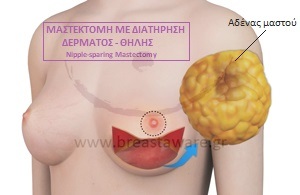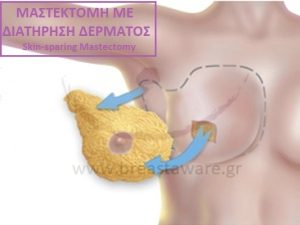
Mastectomy: What It Is, When It Is Indicated, and Modern Options
The mastectomy is a surgical procedure to remove the entire breast and is a therapeutic or prophylactic option for treating breast cancer. Although in most cases of early cancer it is applied lumpectomy (breast conservation), there are specific indications where mastectomy is the most appropriate solution.
What Does the Procedure Involve?
During mastectomy, it is performed sentinel lymph node biopsy, that is, the first lymph node in the armpit that receives lymph from the tumor area. If detected cancer cells, follows armpit lymph node cleaning. The presence or absence of metastases in the lymph nodes helps in cancer staging and affects the subsequent therapeutic approach (chemotherapy, radiotherapy, hormone therapy).

When Is Mastectomy Necessary?
Mastectomy is performed when Breast conservation is not possible or appropriate, as in the following cases:
- Multiple cancer foci in different quadrants of the breast
- Large tumor relative to breast size
- Extensive or inflammatory breast cancer
- Inability to achieve clean surgical margins after lumpectomy
- Pregnancy, where radiotherapy (required after lumpectomy) is contraindicated
- Previous radiotherapy to the same area
- Prophylactic mastectomy in women with BRCA1 or BRCA2 gene mutations
- Concurrent autoimmune diseases, like scleroderma or systemic lupus erythematosus, which impair tolerance to radiotherapy
Types of Mastectomy
Modern surgical techniques allow for the preservation of the skin and/or the nipple, with the aim of immediate or gradual breast reconstruction and a natural aesthetic result. There are four main types:
- Simple Mastectomy
Removal of the entire breast tissue along with overlying skin and nipple. - Modified Radical Mastectomy
Removal of the breast and axillary lymph node dissection - Skin-Sparing Mastectomy
The gland and nipple-areola are removed, but a large part of the skin is preserved. This facilitates reconstruction with silicone insert or autologous tissue (tissue from the woman's own body). - Nipple-Sparing Mastectomy
The most modern type. Only the gland is removed, while both the skin and the nipple-areola are preserved. It is combined with immediate recovery with insert and preferred:
- In carriers of BRCA1/2 mutations for prophylactic reasons
- For cancers located away from the nipple
- In women with small to medium sized breasts, where optimal aesthetic results are achieved

Mastectomy Today: More Than Just Surgery
Mastectomy is no longer just a radical operation; it is part of a holistic approach for the treatment or prevention of breast cancer, incorporating the surgical technology, her aesthetic restoration and the personalized care.
Sources:
- National Comprehensive Cancer Network (NCCN).
- European Society for Medical Oncology (ESMO). ESMO Clinical Practice Guidelines: Early and Locally Advanced Breast Cancer, 2023. Annals of Oncology, 34(10), 2023
- Society of Surgical Oncology (SSO). SSO-ASTRO-ASCO Consensus Guideline on Margins for Breast-Conserving Surgery with Whole-Breast Irradiation in Stage I-II Invasive Breast Cancer (2023 Update). Journal of Clinical Oncology, 41(6), 2023..
- American Society of Breast Surgeons (ASBrS). Position Statement on Prophylactic Mastectomy (2023).
- De La Cruz L, et al. Breast Reconstruction After Mastectomy: A Review of Techniques and Outcomes. Plastic and Reconstructive Surgery, 151(3):531e–544e, 2023.
